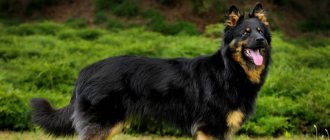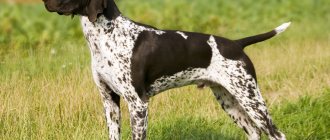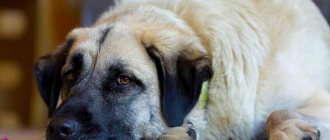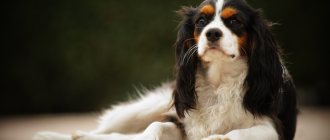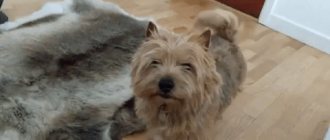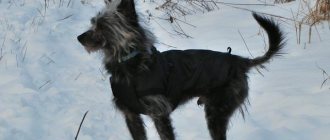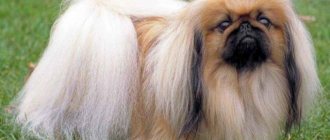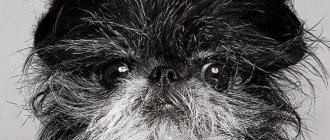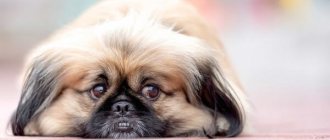Organization of sleeping area and toilet
How to toilet train a Pekingese? The Pekingese is a small dog, which is a plus. If she is taught to go to a special dog toilet while still a puppy, then issues with walking will be resolved by themselves. Train your puppy to use the litter box like this: allocate a limited space and place moisture-absorbing diapers there.
Observe where your baby goes to the toilet most often, and mark these places for yourself. Gradually, the number of diapers should be reduced until one remains, and a dog toilet should be placed in the chosen place. The tray is filled with a special filler that absorbs moisture, or without it at all. Please note that the process of litter box training will require time and patience.
These furry pets love comfort, so owners should take care of a comfortable place for the pet. If you wish, make a sleeping place with your own hands, or you can buy a ready-made soft kennel in a store.
If you have a personal plot, then a booth for your pet would be quite appropriate there. The Pekingese is a short dog, its height is 25 cm. The size of the house can exceed the size of the dog by about 5–10 cm. The booth should not be too large, otherwise the dog will be cold, and the animal will warm a small home with its body. The entrance to the house should be well closed with a waterproof curtain. But to make the booth both spacious and insulated, buy a house with a vestibule.
If you want to build your dog’s home yourself, then prepare the necessary materials: pine boards, insulation, metal tiles. The booth must also be treated with special means. It will be convenient if the roof is removable. Also, choose the right place to install the kennel. The main thing is that the booth should be in a bright, dry and windless place.
General rules
The Pekingese dog is special; it always strives to take the highest positions. If such a dog encounters a weak-willed owner, trouble will inevitably follow; the puppy will happily sit on his neck. One whim that you perform is a leap into the unknown, or rather into the fact that the Pekingese will command you, and you will obey.
As a result, your home may become chaotic, your dog may become overweight, uncontrollable, and even engage in aggressive “negotiations” with other dogs. This can threaten the Pekingese with the loss of an eye (they are especially sensitive) and the risk of injury.
That is why, immediately after the puppy steps onto the threshold of your home, it is you who must command and control the situation. Caring for a Pekingese starts from the beginning and proper upbringing. Training should begin with knowing your name and place.
The puppy should have his own bowl; the Pekingese, even though he is a royal “person,” should be embarrassed to sit on the master’s chair and beg for food from the plate!
The same applies to throwing pieces of food, sausage and other things at lunch. If you are planning a holiday, make it for the dog, only in his “dining room”, giving the dog a treat, not yours.
Teach your Pekingese to sleep in your bedchamber; if you really want to pamper him, it’s better to build a beautiful throne-sleeping place or other boudoir for him, but don’t put him in a bed or on a sofa. The puppy remembers this and gets used to sleeping closer to the owner, at first there is nothing special about it, but as it grows up, you can’t change the dog, and the dog becomes the rightful owner of the bed, you can’t drive him out of there.
To raise a Pekingese, the leader’s tone, the so-called “carrot and stick” method, is important. There is no need to punish a wayward dog, this will provoke resentment. And an offended Pekingese may even cry, why make the dog suffer?
Just send him back to his place if he did something wrong (made a puddle or didn’t listen), stop the game, ignore him, come up with non-offensive words of punishment or knock on the table with a newspaper.
You should spend a lot of time combing the fur, the fluffy will continue to wriggle out of your hands, this is quite understandable, he still does not know how to sit still. It is the owner who can teach him discipline. The puppy will gradually get used to brushing himself, lying down first on his back, then on his side, and standing on the table. All these skills are useful both for participating in exhibitions and simply teaching endurance and patience; such skills are part of proper upbringing.
Care
So, what do you need to know about the care and maintenance of the Pekingese? Let's figure it out. Let's start with the ears.
We recommend this article:
What is tasty and healthy to feed your Pekingese at home?
Behind the ears
The dog's ears have long hair. You should constantly inspect your pet's ears while brushing. Sulfur removal is done with a cotton swab, which must first be moistened in a disinfectant solution (can be purchased at a pet store). If the ears are constantly itching and the dog is constantly shaking his head, then this is a signal to visit the veterinarian.
We recommend this article:
Features and standard of the main types of Pekingese
Behind the wool
Pekingese have long hair with a thick undercoat. This is one of the main decorations of this breed. Therefore, caring for a Pekingese, first of all, involves taking care of the coat, i.e. grooming. At home, the dog needs to be brushed not just often, but daily. The ears, chest, sides, and area under the tail require especially careful combing.
To brush your Pekingese, you will need a long-handled metal comb and a wire brush. When it's hot, your dog could use a haircut. Specialists will groom your Pekingese “like a lion,” and he will be simply magnificent. You can bathe your dog no more than twice a month, but you shouldn’t wash your pet’s face - just wipe it with a damp cloth every day.
We recommend this article:
Features of cutting a Pekingese at home
Behind the teeth
If you feed your dog a balanced professional food, then most likely your pet’s teeth will be healthy. While chewing the granules, the natural plaque is removed. You can often notice yellow discoloration and stains on the teeth. Contact your veterinarian for professional dental calculus removal. To prevent tartar from forming, try brushing your pet’s teeth with a toothbrush, but not all Pekingese agree to put up with this procedure.
Related article: All about the sacred Chinese dog of the Pekingese breed
Behind the claws
Representatives of this breed are not fans of running, which is why Pekingese claws require special care. Nail trimming should be introduced when Pekingese dogs are still puppies. This should not be done often, only when necessary. When trimming claws, only the very tip is cut off; the hair between the toes also needs to be trimmed. If the claws are not given proper attention, this can lead to damage to the claw. Of course, the procedure for trimming nails does not require haste. Purchasing a nail clipper from a specialized store will greatly ease the situation.
Feeding
Feeding is one of the most pressing issues for Pekingese owners. Dogs tend to be picky about food. A feature of the breed is the underdevelopment of fangs, so the meat should be finely chopped or twisted in a meat grinder. Meat and offal are lightly boiled. Cheese is rarely given, except as a reward.
Feeding with vegetables is carried out once a week. Use only those that do not cause bloating. Fermented milk products are given separately or with fruit. Pickles, smoked meats, pasta, potatoes, anything fried, chicken and fish bones are strictly prohibited. To prevent the formation of tartar, you can give beef bones. Proper nutrition will help the owner avoid such an unpleasant problem as diarrhea in the Pekingese.
We recommend this article:
How to choose a beautiful and sonorous name for a Pekingese puppy
Clothing and walking
When the weather is cool outside, despite its long coat, the Pekingese will need clothing. In your winter clothes wardrobe it would be nice to have a warm jumpsuit with padding polyester. Choose a soft fabric, and the overalls themselves should not hinder movement. The dog should feel comfortable in it. In wet weather, clothing for the Pekingese is a jumpsuit with a hood. It is needed to hide long ears. In the summer, a mesh jumpsuit would be a good idea. Of course, the dog is not cold, but protecting its beautiful coat from dust and mites will be very useful.
It’s good if your pet doesn’t have fleas, but as a useful accessory to a summer outfit, a flea collar will be useful. Fashion designers for dogs offer a very useful thing - soft boots. They will protect your paws from dirt and salt on the roads. You can attach a bow to your pet's leash as a decoration. Pekingese are not couch dogs; you need to take them for walks regularly.
How to care for your pet
In order for your dog to be beautiful and healthy, you need to properly and promptly care for it: bathe it, examine it for diseases, walk it, etc.
Wool
Since this dog breed has long and thick hair, it needs to be brushed daily. For this, special soft brushes and combs with sparse, but not very sharp teeth are used. If you find formed tangles in the wool, they need to be sorted out using special means.
Some Pekingese owners cut their pets' hair in the summer, so the dog can withstand the heat more easily. You can get a haircut yourself or in a specialized salon (many veterinary clinics provide such services). You should also remember that dogs of this breed shed quite often, so if you are clean and like a perfectly clean house, then the Pekingese is not the breed that will suit you.
Bathing
You need to bathe your dog regularly (once a month or more often) using special products. After each walk, try to wipe your pet’s paws and private parts with disinfectants, as a lot of dust can collect there. In addition, the dog's fur absorbs all sorts of unpleasant odors very well.
For bathing, you need to use shampoo that is designed for long-haired dogs. You can purchase it at almost any veterinary clinic. After bathing, the dog's fur should be dried with a hairdryer (but at minimum speed). Try not to overdry the wool, as it becomes brittle and brittle. After drying the Pekingese, you need to comb it carefully and vigorously, this way you will not only add beauty to the coat, but also improve blood circulation in the upper layer of the epidermis.
It is also important to understand that regular bathing makes your pet's coat softer and fluffier, while the normal condition of the coat is stiff and manageable. Therefore, try not to bathe your dog immediately before the exhibition.
Inspect for irritations and infections
The weak point of dogs of this breed is their eyes, so they must be treated daily with a special product that can be purchased at a veterinary pharmacy. Eye treatment is carried out using a soft cotton swab. If you cannot purchase an eye treatment, then use strong black tea.
In addition, regularly clean your pet’s ears, because excess wax can cause various complications and infectious diseases. Also inspect the skin for irritations and mites. If you notice any change, you should immediately contact your veterinarian for help.
Important! Vaccination against ticks is not recommended, as it is very toxic (there have even been deaths after vaccination).
This dog breed also often has dental problems. Various diseases and tooth loss may occur from time to time. In addition, Pekingese often develop tartar (to prevent it, regularly remove the buds; you can even do this with your fingernail).
Veterinary pharmacies offer special toothpastes that can protect your pet’s teeth.
Buy a soft toothbrush and brush your dog's teeth at least once a week . To prevent the formation of tartar, your dog can be given raw chicken bones (but not boiled ones, as they can cause problems with the digestive tract).
Activity and walks
You need to walk your Pekingese regularly (strictly at a certain time). Take walks several times a day. In the summer, when the daytime temperature is excessively high, you should only walk your dog in the early morning and late evening. Before regular walks, your pet will need protection from fleas and ticks. You can buy it at veterinary pharmacies in the form of drops or a special collar.
It is important to note that due to their bravery, Pekingese are often subject to threats. They will never run away from large fighting dogs, so they can get hurt by their teeth. You need to know this while walking, and it is best to carry a special gas spray with you, which you can use to scare away large fighting or hunting dogs.
In addition, the cat can also harm the dog with its claws, especially its nose, which is already poorly permeable to air masses. One more point: only walk your dog on a leash, because if it tries to keep up with someone, it will not be so easy to catch up with it.
Training and education
Representatives of this breed are reserved, self-confident, and very stubborn. They will not tolerate loud shouts and fuss. Many owners often have a question: how to train a Pekingese, and why does the dog refuse to follow commands? Note that training a dog should be based on its natural characteristics. Using the same training methods for Pekingese dogs as for Shepherd dogs is a waste of time. A stubborn dog will not “dance to your tune” just because you are its owner.
Similar article: Features of cutting a Pekingese dog at home
Raising and training the Pekingese should begin as early as 2–3 months. A puppy's thirst to learn new things will help the owner instill in the baby the necessary skills and teach him commands. You need to accustom the puppy to its name, its place, and the leash. Owners who do not train on time have big problems when their pets grow up.
Common diseases and vaccinations
Vaccination is an important stage in a pet’s life. This simple procedure, performed on time, will save your dog from many illnesses. Only healthy animals can be vaccinated. You need to start doing this from an early age. Pekingese puppies receive their first vaccinations at 8–9 weeks.
Pekingese can experience various diseases, including demodicosis, malassezia, and tartar formation. One of the most vulnerable places is the eyes. The Pekingese's eyes need to be constantly monitored and cared for. These dogs often injure the eyeball; they may even develop an eyesore. The owner's first aid kit should contain chloramphenicol drops.
If a Pekingese's eyes fester, it means that something got there or you missed an injury, and the inflammatory process began. Carefully remove the pus from the corners and immediately contact a specialist. Do not try to solve the problem yourself; treatment methods should be determined by a veterinarian.
Subtle clouding of the cornea or leukoma may indicate corneal erosion, a specific disease that affects this breed. An eyesore also appears as a result of conjunctivitis and even allergies when the process has been started. An eyesore is not so easy to cure, so it’s better not to let it get to that point.
Demodicosis is also a common disease. Its causative agent is a microscopic mite. The dog is constantly itching - this is the first sign that the pet has demodicosis. An animal can scratch itself for several hours in a row, then redness appears, and after a few days an ulcer appears at the site of each scratch. If the Pekingese is not treated, it may die, so a dog that is constantly itching should be immediately alerted; there is no need to let the situation develop into festering wounds. The disease does not go away on its own; demodicosis can last for years, which will ultimately lead to blood poisoning.
The main reason why the Pekingese is affected by the pathogen is weakened immunity. The treatment procedure is aimed at relieving the itching syndrome - destroying the pathogen, removing purulent lesions, and restoring immunity. Curing demodicosis will take time and patience.
Malassezia is another skin disease. Its causative agent is Malassezia yeast fungus. It always lives on the animal’s fur and develops only with reduced immunity. The main symptom is itchy skin, which causes the dog to constantly itch. The Pekingese tries to get rid of the unpleasant sensation, but in fact, when it itches, it spreads the mange throughout its body. As soon as you notice alarming symptoms, contact the veterinary clinic immediately.
Now a little about other diseases. Don't let your pet jump off the couch too often to avoid injury and hind leg failure. Have you noticed that the animal rides on its butt? So, it's time to give anthelmintic. However, this is not the only reason why a dog rolls on the floor. It is possible that the anal glands are clogged with mucus, which causes severe itching. The dog rides on its butt to get rid of the unpleasant sensation. How to treat? It is better to seek help from a specialist. Note that after the dog has been cured, you need to monitor it, because often the gland “clogs” again.
Similar article: How to choose a beautiful and sonorous name for a Pekingese puppy
Also make sure that your pet does not develop tartar. Check your Pekingese's teeth, brush them several times a week, and feed them high-quality food. Tartar can cause teeth to fall out.
Vaccination and deworming
These are important aspects, without which the care and maintenance of the Pekingese is impossible. Mother's milk, of course, supplies the body with everything it needs and these two procedures are not recommended for Pekingese until the age of 2 months. Due to the sensitive body and also because mother’s milk acts as a kind of vaccination.
When the puppy came into your hands, you were probably aware of the vaccinations carried out, if any. All of them will be noted in the veterinary passport. After birth, the puppy is dewormed, after which the procedure is repeated every quarter. Now these responsibilities pass to the owner of the Pekingese.
Deworming should be carried out every three months, and at this time you should monitor the puppy’s coat and skin so that other parasites - fleas and ticks - do not appear there. Timely disposal of both “enemies” is already a guarantee of health. Without parasites there are much fewer diseases and problems.
It should be noted that the Pekingese is a dog with a short loin, so from time to time it has problems with the anal glands. Unknowingly, you may think your dog has worms when your Pekingese starts rubbing itself on the floor or biting its behind.
Do not poison your dog again with tablets, especially if you regularly get rid of worms. At this point, you need to help the Pekingese go to the toilet normally and free the anal glands from secretions.
Vaccination and deworming are related. So, vaccinations should be done only after the parasites have been expelled from the Pekingese’s body. This rule is very important, since the puppy is still weak and may not be able to withstand the double load. The worms themselves can often lead to bad consequences and even death. And if, in addition to worm toxins, strains of bacteria enter the body (vaccination), the matter worsens even more.
You cannot go for a walk without double vaccination, and, of course, you should drive away worms using Pyrantel syrup, since it is the least allergenic for Pekingese. Without this, the dog may pick up even more of them.
Owners are often concerned about the question - why do Pekingese stink? There may be several reasons - the fold is not cleaned enough and it is wet, the ears are dirty, inflammation in the mouth, uncleaned anal glands, males smell stronger. One of the reasons may be poor-quality food, which the sensitive stomach of the Pekingese does not accept.
Pekingese breeding
Estrus
Pekingese bitches go into heat the same way as other breeds. A responsible owner always knows when his dog's estrus should begin and approximately how long it lasts. As soon as a puppy appears in the house, immediately start a notebook to write down all the data that you need to remember about the pet: when the vaccination was done, when the anthelmintic was given, the beginning of each heat, the days the Pekingese was due, how many puppies there were, etc.
However, it's rare for her to go into heat the same day, so keep an eye on your girl as her due date approaches. If you are planning to knit, do not miss the first day, because this is where you will count down to knitting. It's not scary if the dog has dark blood for the first couple of days, then it should lighten. When the discharge has become mucous, it is time for mating.
Mating
Breeding Pekingese is a responsible matter. First of all, you need to find a suitable male dog. It is advisable that pregnancy occurs already at the first mating of the Pekingese, because it may become the only one, even if everything ends successfully for both the offspring and the bitch.
Before taking your dog for breeding, you need to walk it. It is better to arrive at the place in advance so that the girl can look around and get used to the place. It happened that a bitch refused a dog because she thought that her owner had abandoned her. However, it is not always possible to introduce dogs before mating.
Dogs should not be left alone. You need to make sure that the bitch does not bite the dog. Mating can even take place on the table. Stand nearby while mating continues to help the male remain steady. When the dogs have separated, you can turn the bitch on her back, although this is not important - pregnancy occurs in most cases.
How to tell if a Pekingese dog is pregnant or not? Observe your pet's behavior. Pregnant dogs become lethargic and their appetite increases. You can slightly increase the daily food intake, but do not overfeed, otherwise the puppies will be too large and you will have to have a caesarean section.
Childbirth
A clear sign that labor is about to occur is a drooping belly. Also, the expectant mother's nipples swell and her body temperature may drop. Within a couple of days, the female begins to worry and look for a secluded place. The process itself begins with the appearance of mucus, then the water breaks. Childbirth lasts quite a long time, as it has three stages. How old do puppies grow? Typically, their active growth lasts 60 days.
We recommend this article:
How long do Pekingese live on average and what does it depend on?
Video "Grooming Pekingese"
From this video you will learn how to cut your Pekingese haircut at home.
Recommended Posts
Features of cutting a Pekingese at home
What is tasty and healthy to feed your Pekingese at home?
How to choose a beautiful and sonorous name for a Pekingese puppy
All about the sacred Chinese Pekingese dog
Features and standard of the main types of Pekingese
Rules for the care and maintenance of the Shih Tzu breed at home
What not to feed a Pekingese
What should you not feed your Pekingese? When cooking, it is better not to add any spices, including salt. As mentioned earlier, fatty foods are contraindicated for this breed, as they contribute to rapid weight gain, which is undesirable. Other foods that have no place in the Pekingese diet include:
- White cabbage
- All types of legumes
- Onion
- Potato
- Bakery products
- Chocolate
All of the above products can cause disruption in the pet’s digestive system, most often this is flatulence.
